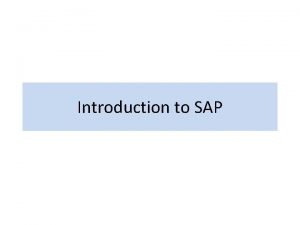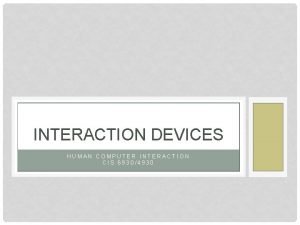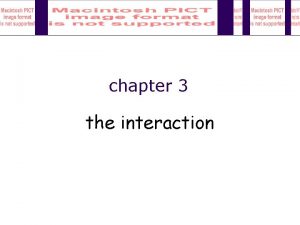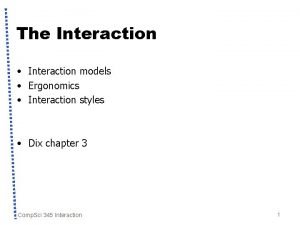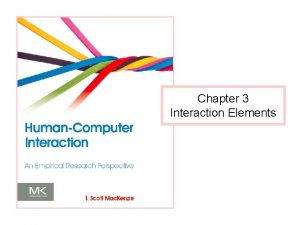Interaction Types for products or systems Interaction types


















- Slides: 18

Interaction Types for products or systems

Interaction types • Instructing – issuing commands using keyboard and function keys and selecting options via menus • Conversing – interacting with the system as if having a conversation • Manipulating - acting on objects and interacting with virtual objects • Exploring – finding out and learning things

Instructing • Where users instruct the system and tell it what to do – e. g. tell the time, print a file, save a file • Very common conceptual model, underlying a diversity of devices and systems – e. g. CAD, word processors, VCRs, vending machines • Main benefit : instructing supports quick and efficient interaction – good for repetitive kinds of actions performed on multiple objects

ty i v i t c A Vending machines How is the interaction different? Which is more complex Problems with complexity Refer to your text for a discussion 2002 p. 43/44 2007 p. 66/7

Conversing • Like having a conversation with another human • Range from simple voice recognition menu-driven systems to more complex ‘natural language’ dialogues • Examples include timetables, search engines, advice-giving systems, help systems • Differs from instructing in that it is more like two-way communication, with the system acting like a partner rather than a machine that obeys orders Benefits? Issues?

Pros and cons of conversational model + Pros - Cons • • Allows users, especially novices and technophobes, to interact with the system in a way that is familiar – makes them feel comfortable, at ease and less scared Misunderstandings can arise when the system does not know how to parse what the user says – e. g. child types into a search engine, that uses natural language the question: “How many legs does a centipede have? ” and the system responds:


Manipulating • Exploit’s users’ knowledge of how they move and manipulate in the physical world • Virtual objects can be manipulated by moving, selecting, opening, and closing them • Tagged physical objects (e. g. , bricks, blocks) that are manipulated in a physical world (e. g. , placed on a surface) can result in other physical and digital events

Manipulatives (Pico. Crickets)

Direct manipulation • Shneiderman (1983) coined the term Direct Manipulation • Came from his fascination with computer games at the time • Proposes that digital objects be designed so they can be interacted with analogous to how physical objects are manipulated • Assumes that direct manipulation interfaces enable users to feel that they are directly controlling the digital objects

Core principles of DM • Continuous representation of objects and actions of interest • Physical actions and button pressing instead of issuing commands with complex syntax • Rapid reversible actions with immediate feedback on object of interest

Why are DM interfaces so enjoyable • Novices can learn the basic functionality quickly • Users can immediately see if their actions are furthering their goals and if not do something else • Experienced users can work extremely rapidly to carry out a wide range of tasks, • Users experience less even defining new functions anxiety • Intermittent users can retain operational concepts over time • Users gain confidence and mastery and feel in control • Error messages rarely needed

ty i v i t c A How did the apple desktop use the conceptual model of direct manipulation? • Where did problems occur? • Why? Text p 48 Text p 73

What are the disadvantages with DM? • Some people take the metaphor of direct manipulation too literally • Not all tasks can be described by objects and not all actions can be done directly • Some tasks are better achieved through delegating rather than manipulating – e. g. , spell checking • Moving a mouse around the screen can be slower than pressing function keys to do same actions

Exploring • Involves users moving through virtual or physical environments • Examples include: – 3 D desktop virtual worlds where people navigate using mouse around different parts to socialize (e. g. , Second Life) – CAVEs where users navigate by moving whole body, arms, and head – physical context aware worlds, embedded with sensors, that present digital information to users at appropriate places and times

ty i v i t c A Have a go • What interaction types are used in the following products: • A 3 D car racing video game that uses a steering wheel, and tactile , audio and visual feedback Direct manipulation of virtual worlds • Windows Hybrid: DM; instructions; conversations • A web browser Hybrid: explore and browse; instructions;

Which interaction type? • Direct manipulation is good for ‘doing’ types of tasks, e. g. designing, drawing, flying, driving, sizing windows • Having a conversation is good for children, computer-phobic, disabled users and specialised applications (e. g. phone services) • Instructing is good for repetitive tasks, e. g. spellchecking, file management • Hybrid interaction types are often employed, where different ways of carrying out the same actions is supported at the interface - but can take longer to learn

Summary points • Interaction types (e. g. , conversing, instructing) provide a way of thinking about how best to support the activities users will be doing when using a product or service
 Functional and innovative products supply chain
Functional and innovative products supply chain Marketing mix of pepsi
Marketing mix of pepsi Systems applications and products in data processing
Systems applications and products in data processing System applications and products
System applications and products Systems applications and products
Systems applications and products Systems applications and products
Systems applications and products Fspos vägledning för kontinuitetshantering
Fspos vägledning för kontinuitetshantering Typiska novell drag
Typiska novell drag Tack för att ni lyssnade bild
Tack för att ni lyssnade bild Ekologiskt fotavtryck
Ekologiskt fotavtryck Varför kallas perioden 1918-1939 för mellankrigstiden
Varför kallas perioden 1918-1939 för mellankrigstiden En lathund för arbete med kontinuitetshantering
En lathund för arbete med kontinuitetshantering Personalliggare bygg undantag
Personalliggare bygg undantag Vilotidsbok
Vilotidsbok Sura för anatom
Sura för anatom Densitet vatten
Densitet vatten Datorkunskap för nybörjare
Datorkunskap för nybörjare Stig kerman
Stig kerman Hur skriver man en tes
Hur skriver man en tes




